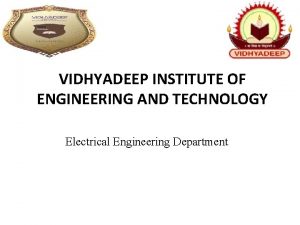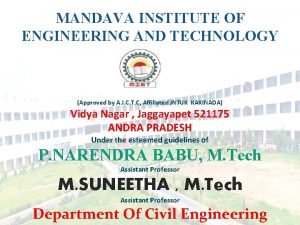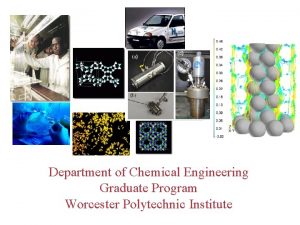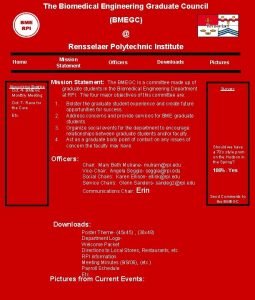GURU NANAK INSTITUTE OF ENGINEERING AND MANAGEMENT Mechanical















- Slides: 15

GURU NANAK INSTITUTE OF ENGINEERING AND MANAGEMENT Mechanical Engineering Department

SEMINAR ON ANTI LOCK BRAKING SYSTEM Guided By: Er. Shaymal Chakrabarty Presented By: Sumit O. Ambekar

Introduction to ABS: l Applying brakes too hard, or on a slippery surface, can cause the wheels to lock. When wheels lock, steering control is lost and, in most cases, it produces longer stopping distances. The antilock braking system prevents wheels locking or skidding, no matter how hard brakes are applied, or how slippery the road surface. Steering stays under control and stopping distances are generally reduced.

Working of ABS: l When the driver hits the brakes this pressurizes the hydraulic system which causes the brake pads to squeeze against the discs which causes the car to slow down. If the ABS system detects that one wheel is slowing down more rapidly than the rest it automatically reduces the brake pressure on this wheel by opening a pressure release valve in the hydraulic system. ABS also has the ability to build the pressure back up via the hydraulic motor. The system reacts remarkably quickly, and compared wheel speeds many times a second.

Diagram 1: Brake caliper (1), wheel speed sensor (2)

Diagram 2:

Diagram 3:

History: l The ABS was first developed for aircraft use in 1929. l In 1958, Royal Enfield Motorcycle.

Components: There are four main components to an ABS: l Speed sensors, l Valves, l Pump, l Controller.

Basic Functions of ABS: l l Static Friction is Greater than Moving Friction. ABS Allows the Driver To Maintain Control During Hard Braking.

Advantages of ABS: l Stopping on ice. l Higher resale value l ABS is really helpful in tricky situations like corner braking. .

Disadvantages of ABS: l It is expensive. l It hard to install. l Delicate systems.

Reference: l www. abs-education. org l www. teambhp. com l www. drivingfast. net l www. fmcsa. dot. gov

Thanks!

Submitted by: l Sumit O. Ambekar +919730922304
 Sohin mehta
Sohin mehta Guru nanak institutions technical campus
Guru nanak institutions technical campus Kesh kara kanga kaccha kirpan
Kesh kara kanga kaccha kirpan Stevens institute of technology mechanical engineering
Stevens institute of technology mechanical engineering Stevens institute of technology mechanical engineering
Stevens institute of technology mechanical engineering Tembang dhandhanggula pamedhare wasitaning ati
Tembang dhandhanggula pamedhare wasitaning ati Miwah ingkang tata krama tembung miwah tegese
Miwah ingkang tata krama tembung miwah tegese Ukara panyaruwe yaiku
Ukara panyaruwe yaiku Actual mechanical advantage vs ideal mechanical advantage
Actual mechanical advantage vs ideal mechanical advantage Vidhyadeep institute of engineering and technology
Vidhyadeep institute of engineering and technology Mandava institute of engineering and technology
Mandava institute of engineering and technology Graduate institute of electronics engineering
Graduate institute of electronics engineering Worcester polytechnic institute chemical engineering
Worcester polytechnic institute chemical engineering Grenoble
Grenoble Rensselaer polytechnic institute electrical engineering
Rensselaer polytechnic institute electrical engineering Rensselaer polytechnic institute biomedical engineering
Rensselaer polytechnic institute biomedical engineering



























